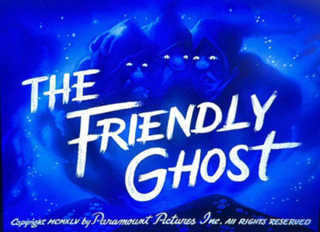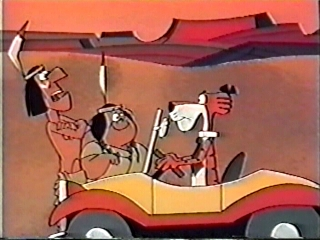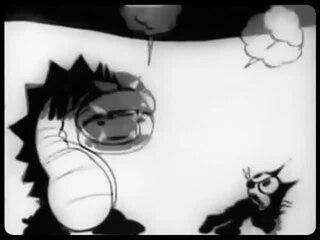
Felix the Cat is a cartoon character created in 1919 by Pat Sullivan and Otto Messmer during the silent film era. An anthropomorphic young black cat with white eyes, a black body, and a giant grin, he is often considered one of the most recognized cartoon characters in history. Felix was the first fully realized recurring animal character in the history of American film animation.

Scaredy Cat is a 1948 Warner Bros. Merrie Melodies cartoon directed by Chuck Jones. The short was released on December 18, 1948, and stars Porky Pig and Sylvester the Cat. The cartoon is notable in that it marks the first time the name "Sylvester" is used for the popular feline character. In previous shorts, the cat is unnamed, except for in the 1947 cartoon Tweetie Pie in which he is referred to as "Thomas".

An Itch in Time is a 1943 Warner Bros. Merrie Melodies cartoon, directed by Bob Clampett. The short was released on December 4, 1943 and features Elmer Fudd, with a dog and cat that look similar to Willoughby and Claude Cat.

King-Size Canary is an animated cartoon short that debuted in movie theaters in 1947. It was produced by Metro-Goldwyn-Mayer and directed by Tex Avery. The canary in this short was a primary inspiration for the design of Maurice, a character from The Wacky World of Tex Avery.

Gift Wrapped is a 1952 Warner Bros. Looney Tunes animated cartoon directed by Friz Freleng. The short was released on February 16, 1952, and stars Tweety and Sylvester.

The Friendly Ghost is a Famous Studios cartoon released on 16 November 1945 as part of its Noveltoons series of animated short films. It is the first cartoon to feature the character Casper the Friendly Ghost.

Peter & the Wolf is a Polish-British-Norwegian stop-motion animated short film released in 2006. Written and directed by Suzie Templeton and scenography by Marek Skrobecki, it was made in Se-ma-for Studios in Łódź and has been shown in cinemas, sometimes with live musical accompaniment. The film won the Academy Award for the Best Animated Short Film at the 80th Academy Awards.

Injun Trouble is a 1969 Merrie Melodies cartoon, directed by Robert McKimson. The cartoon was released on September 20, 1969, and features Cool Cat. It is noted for being the last cartoon in the original Merrie Melodies series, ending a run that had continued since 1931, as well as the whole original Looney Tunes/Merrie Melodies series from 1930-1969. Additionally, this was the 1,000th cartoon short released by Warner Bros.

Woos Whoopee is a surreal, animated 1930 Felix the Cat short subject produced by Pat Sullivan.

Alice in Wonderland is a 1949 French film based on Lewis Carroll's 1865 fantasy novel Alice's Adventures in Wonderland. Directed by Dallas Bower, the film stars Carol Marsh as Alice, Stephen Murray as Lewis Carroll, and Raymond Bussières as The Tailor. Most of the Wonderland characters are portrayed by stop-motion animated puppets created by Lou Bunin.

Mouse Wreckers is a 1949 Warner Bros. Looney Tunes short directed by Chuck Jones, written by Michael Maltese and starring Hubie and Bertie in their first pairing with the redesigned Claude Cat. The cartoon was released on April 23, 1949.
Spooks is a 1930 animated short subject produced by Walter Lantz and stars Oswald the Lucky Rabbit.

Rodeo Dough is a 1931 American short animated Western film by Columbia Pictures, and stars the comic strip character Krazy Kat.
Forty Winks is an animated short film made by the Pat Sullivan Studio, and is among the Felix the Cat shorts.

Felix the Cat Trifles with Time is a 1925 animated, black and white, silent short film by Pat Sullivan Studios, featuring Felix the Cat. Produced by E. W. Hammons, it featured the work of the animator Otto Messmer, Hal Walker, Burton Gillett, Dana Parker, and Jack Bogle. It was the first cartoon of the series to be distributed by Educational Pictures.

Felix Finds Out is a 1924 short animated film distributed by M.J. Winkler Productions, and among the many theatrical cartoons featuring Felix the Cat.

Scooby-Doo! Stage Fright is a 2013 direct-to-DVD animated musical comedy horror film, and the twenty-first entry in the direct-to-video series of Scooby-Doo films. It was released on August 20, 2013, by Warner Premiere, the last film to be released under this label due to its dissolution the previous year. The movie made its linear premiere on Cartoon Network in the United States on March 25, 2023.

Whys and Other Whys is a 1927 silent animated short subject featuring Felix the Cat.

Make Something Up: Stories You Can't Unread is a collection of short stories published on May 26, 2015, and written by Chuck Palahniuk.
Porky's Garden is a 1937 Warner Bros. Looney Tunes animated cartoon directed by Tex Avery. The short was released on September 11, 1937, and stars Porky Pig.* This cartoon's theme is a Looney Tunes theme from 1937, known as Porky Signature theme, but not "The Merry-Go-Round Broke Down", which would be first used as the opening theme in "Rover's Rival". However, a few bars of "The Merry-Go-Round Broke Down" are played when the Podunk fair is introduced. This predates the use of "The Merry-Go-Round Broke Down" as the Looney Tunes theme, and is one of the earliest uses of this song in the Warner Brother's cartoons, the last cartoon that Elmer Wait animated; he died about two months prior to the release. The film entered the Public Domain in 1965.

















